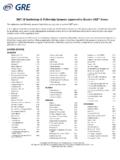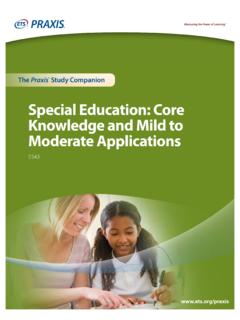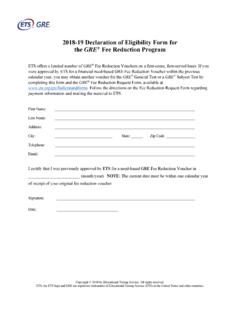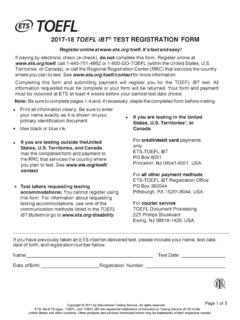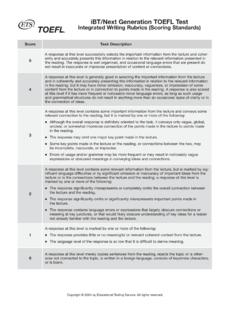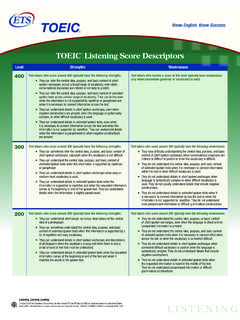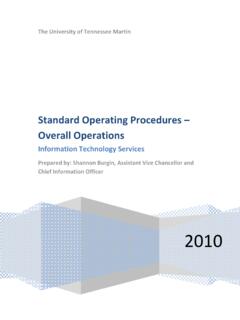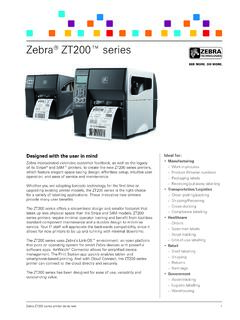Transcription of GRE BIOCHEMISTRY TEST PRACTICE BOOK
1 GRE BIOCHEMISTRY , Cell and Molecular Biology TestPractice BookThis PRACTICE book contains one actual, full-length GRE BIOCHEMISTRY , Cell and Molecular Biology Test test-taking strategiesBecome familiar with test structure and content test instructions and answering proceduresCompare your PRACTICE test results with the performance of those who took the test at a GRE GRE BIOCHEMISTRY Test PRACTICE Book Dr01 4/17/08 ta Dr02 5/7/08 ta Dr03 5/20/08 ta [NEW 108353] CS6 Dr01 5/1/15 jw Dr02 6/1/15 jw Dr03 6/11/15 jw Dr03 int1 6/15/15 jw Dr04 6/22/15 jw [New Job] 007884-113203 Drft01 3/22/16 ew PDF-ACC Drft01 3/28/16 ewTable of ContentsOverview.
2 3 Test Content ..3 Preparing for the Test ..5 Test-Taking Strategies ..5 What Your Scores Mean ..6 Taking the PRACTICE Test ..6 Scoring the PRACTICE Test ..6 Evaluating Your Performance ..7 PRACTICE Test ..9 Worksheet for Scoring the PRACTICE Test ..58 Score Conversion Table ..59 Answer Sheet ..60 Copyright 2016 by Educational Testing Service. All rights reserved. ETS, the ETS logo, GRADUATE RECORD EXAMINATIONS, and GRE are registered trademarks of Educational Testing Service (ETS) in the United States and other countries. MEASURING THE POWER OF LEARNING is a trademark of takers with disabilities or health-related needs who need test preparation materials in an alternate format should contact the ETS Office of Disability Services at For additional information, visit | PageGRE BIOCHEMISTRY , Cell and Molecular Biology Test PRACTICE BookOverview The GRE BIOCHEMISTRY , Cell and Molecular Biology Test consists of approximately 170 multiple-choice questions.
3 A number of which are grouped in sets toward the end of the test and based on descriptions of laboratory situations, diagrams or experimental results. Testing time is 2 hours and 50 minutes; there are no separately-timed sections. This publication provides a comprehensive overview of the GRE BIOCHEMISTRY , Cell and Molecular Biology Test to help you get ready for test day. It is designed to help you: Understand what is being tested Gain familiarity with the question types Review test-taking strategies Understand scoring PRACTICE taking the testTo learn more about the GRE Subject Tests, visit Test ContentThe content of the test is organized into three major areas: BIOCHEMISTRY , cell biology, and molecular biology and genetics.
4 In addition to the total score, a subscore in each of these subfield areas is reported. Because these three disciplines are basic to the study of all organisms, test questions encompass both eukaryotes and prokaryotes. Throughout the test, there is an emphasis on questions requiring problem-solving skills (including mathematical calculations that do not require the use of a calculator) as well as content knowledge. While only two content areas in the following outline specifically mention methodology, questions on methodology and data interpretation are included in all of the diversity of undergraduate curricula, few test takers will have encountered all of the topics in the content outline.
5 Consequently, no test taker should expect to be able to answer all questions on the edition of the test he or she three subscore areas are interrelated. Because of these interrelationships, individual questions or sets of questions may test more than one content area. Therefore, the relative emphases of the three areas in the following content outline should not be considered definitive. Likewise, the topics listed are not intended to be all-inclusive but, rather, representative of the typical undergraduate BIOCHEMISTRY (36%) A. Chemical and Physical Foundations Thermodynamics and kineticsRedox statesWater, pH, acid-base reactions and buffersSolutions and equilibria Solute-solvent interactionsChemical interactions and bondingChemical reaction mechanisms B.
6 Structural Biology: Structure, Assembly, Organization, and Dynamics Small molecules Macromolecules ( , nucleic acids, polysaccharides, polypeptides, complex lipids)Supramolecular complexes ( , membranes, ribosomes, multienzyme complexes)Macromolecular structure and functionC. Catalysis and Binding Enzyme reaction mechanisms and kinetics Ligand-protein interaction ( , receptors, substrates and effectors, transport proteins, antigen-antibody interactions)Interplay between structure and functionD. Major Metabolic Pathways Carbon, nitrogen, and sulfur assimilation Anabolism Catabolism Synthesis and degradation of macromolecules E.
7 Bioenergetics Energy transformations at the substrate level Electron transport Proton and chemical gradients Energy coupling ( , phosphorylation, transport)4 | PageGRE BIOCHEMISTRY , Cell and Molecular Biology Test PRACTICE BookF. Regulation and Integration of Metabolism Covalent modification of enzymes Allosteric regulation Compartmentation Hormones G. Methods Biophysical approaches ( , spectroscopy, x-ray crystallography, mass spectroscopy)Isotopes Separation techniques ( , centrifugation, chromatography, electrophoresis)ImmunotechniquesMacromol ecular structureII.
8 Cell Biology (28%)Methods of importance to cellular biology, such as fluorescence probes ( , FRAP, FRET, GFP), imaging , cell sorting, and proteomics will be covered as appropriate within the context of the content below. A. Cellular Compartments of Prokaryotes and Eukaryotes: Organization, Dynamics and Functions Cellular membrane systems ( , structure, function, transport across membranes, water regulation)Nucleus ( , envelope, matrix, nuclear transport)Mitochondria and chloroplasts ( general function, biogenesis and evolution)B.
9 Cell Surface and Communication (in context of development and adult organisms) Extracellular matrix (including cell walls)Cell adhesion and junctions Signal transduction Receptor function Excitable membrane systems C. Cytoskeleton, Motility, and Shape Regulation of assembly and disassembly of filament systems Motor function, regulation, and diversity Muscle functionCell motilityD. Protein, Processing, Targeting, and Turnover Translocation across membranes Posttranslational modification Intracellular trafficking Secretion and endocytosis Protein turnover ( , proteosomes, lysosomes, damaged protein response)E.
10 Cell Division, Differentiation and Development Cell cycle, mitosis, and cytokinesis Meiosis and gametogenesis Fertilization and early embryonic development (including positional information, homeotic genes, tissue- specific expression, nuclear and cytoplasmic interactions, growth factors and induction, environment, stem cells and polarity)Stem cells (embryonic and adult, roles in development)III. Molecular Biology and Genetics (36%)A. Genetic Foundations Mendelian and non-Mendelian inheritance Transformation, transduction, and conjugation Recombination and complementation Mutational analysis Genetic mapping and linkage analysis B.
